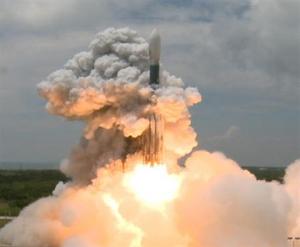
|
| ©REUTERS/NASA TV |
| The GLAST spacecraft and Delta II rocket blasts off from Cape Canaveral Air Force Station in Florida, June 11, 2008. |
Gamma rays are millions to hundreds of billions of times more powerful that what can be seen with the unaided eye.
This type of radiation is produced by the most violent phenomena in the universe, such as the gravitational clamps of black holes and the magnetic fields of star cores so dense with matter that a tablespoon would weigh a billion tons.
The $690 million Gamma-ray Large Area Space Telescope known as GLAST is expected to probe these objects and hundreds more of unknown origin.
It picks up work left unfinished by the pioneering Compton Gamma Ray Observatory, which operated from 1991 to 2000 in orbit.
"Every time you push the boundaries and do something an order of magnitude better than you've done before, you always wind up with new discoveries," said John Morse, director of NASA's astrophysics division at the agency's Washington headquarters.
GLAST has a wide field of view and will scan every three hours. It was delivered into orbit around Earth aboard a United Launch Alliance Delta rocket, which blasted off at 12:05 p.m. EDT. The telescope was designed to last five years, but scientists are hoping it will last twice as long.
Among the telescope's targets:
* Supermassive black holes, which are believed to reside in most, if not all, galaxies. Though these objects, which emit no light, cannot be studied directly, they have a powerful impact on their surroundings, generating jets of highly energized gas and particles, for example, that are blown completely out of the host galaxies.
* Gamma ray bursts, which in a matter of seconds can radiate more energy than our sun will during its entire 10 billion year lifetime. An instrument on the Compton Telescope found 271 gamma ray bursts. The origin of 171 of them remains unknown.
* The speed of light, which may or may not be uniform in a vacuum. Albert Einstein's special theory of relativity states that electromagnetic radiation should travel at the same speed, which is 186,282.4 miles per second (299,700 km per second), no matter how short or long its wavelengths. That may not be true, however, when it comes to very high-energy gamma rays, which may be affected by subatomic particle interactions that can boost or slow their speed.



Reader Comments
to our Newsletter